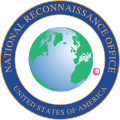


BYEMAN codenamed LANYARD, the KH-6 was the unsuccessful first attempt to develop and deploy a very high-resolution optical reconnaissance satellite by the United States National Reconnaissance Office. [1] Launches and launch attempts spanned the period from March to July 1963. The project was quickly put together to get imagery of a site near Leningrad suspected of having anti-ballistic missiles. [2]
Contents
The satellite carried Itek's "E-5" camera developed for the SAMOS program, which had been cancelled. The camera had a focal length of 1.67 m (5 ft 6 in) and could discern objects on the ground 1.8 m (5 ft 11 in) in size. The ground swath of the camera was 14 km × 74 km (8.7 mi × 46.0 mi). The satellite weighed 1,500 kg (3,300 lb), and had a single re-entry vehicle in which exposed film was returned to earth for a mid-air [3] aircraft recovery.
The KH-6 was manufactured by Lockheed Martin and launched from Vandenberg Air Force Base on Thor-Agena D launch vehicles. [4]
